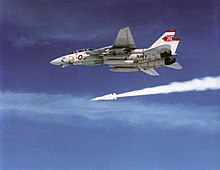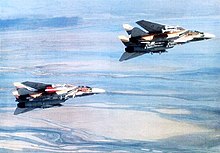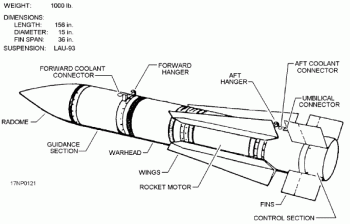|
AIM-54 Phoenix
The AIM-54 Phoenix is an American active radar-guided, beyond-visual-range air-to-air missile (AAM), carried in clusters of up to six missiles on the Grumman F-14 Tomcat, its only operational launch platform. The AIM-54 Phoenix was the United States' only operational long-range AAM during its service life; its operational capabilities were supplemented by the AIM-7 Sparrow (and later, the AIM-120 AMRAAM), which served as the primary medium-range AAM and the AIM-9 Sidewinder, serving as the primary short-range or "dogfight" AAM. The combination of Phoenix missile and the Tomcat's AN/AWG-9 guidance radar meant that it was the first aerial weapons system that could simultaneously engage multiple targets. Due to its active radar tracking, the brevity code "Fox Three" was used when firing the AIM-54. The act of the missile achieving a radar lock with its own radar is known under brevity as "Going Pitbull". Both the missile and the aircraft were used by Iran and the United States Navy (USN). In US service both are now retired, the AIM-54 Phoenix in 2004 and the F-14 in 2006. They were replaced by the shorter-range AIM-120 AMRAAM, employed on the F/A-18 Hornet and F/A-18E/F Super Hornet; in its AIM-120D version, the latest version of the AMRAAM just matches the Phoenix's maximum range.[2] In July 2024, the USN announced the operational fielding of the AIM-174, the "Air-Launched Configuration"[3] of the RIM-174 Standard ERAM, the first dedicated long-range AAM to be fielded by the U.S. military since the AIM-54's retirement.[4] While details regarding the AIM-174's range are unconfirmed, certain surface-launched RIM-174 variants are capable of 250 nmi (290 mi; 460 km) launches. With the benefit of being launched already at-speed and at-altitude (where the air is thinner and thus easier to fly through), combined with additional lofting, the AIM-174's range may extend to several hundred miles,[5] though the USN has confirmed a range of 130 nmi (150 mi; 240 km), about a 30% increase in range over the AIM-54C.[6][7] The AIM-54 has been used in 62 air-to-air strikes, all by Iran during the eight-year Iran–Iraq War.[8][9] Following the retirement of the F-14 by the USN, the weapon's only current operator is the Islamic Republic of Iran Air Force. DevelopmentBackgroundSince 1951, the Navy faced the initial threat from the Tupolev Tu-4K 'Bull' carrying[10] anti-ship missiles or nuclear bombs. Eventually, during the height of the Cold War, the threat would have expanded into regimental-size raids of Tu-16 Badger and Tu-22M Backfire bombers equipped with low-flying, long-range, high-speed, nuclear-armed cruise missiles and considerable electronic countermeasures (ECM) of various types. This combination was considered capable of saturating fleet defenses and threatening carrier groups. The Navy would require a long-range, long-endurance interceptor aircraft to defend carrier battle groups against this threat. The proposed Douglas F6D Missileer was intended to fulfill this mission and oppose the attack as far as possible from the fleet it was defending. The weapon needed for interceptor aircraft, the Bendix AAM-N-10 Eagle, was to be an air-to-air missile of unprecedented range when compared to contemporary AIM-7 Sparrow missiles. It would work together with Westinghouse AN/APQ-81 radar. The Missileer project was cancelled in December 1960. AIM-54 In the early 1960s, the U.S. Navy made the next interceptor attempt with the F-111B, and they needed a new missile design. At the same time, the USAF canceled the projects for their land-based high-speed interceptor aircraft, the North American XF-108 Rapier and the Lockheed YF-12, and left the capable AIM-47 Falcon missile at a quite advanced stage of development, but with no effective launch platform. The AIM-54 Phoenix, developed for the F-111B fleet air defense fighter, had an airframe with four cruciform fins that was a scaled-up version of the AIM-47. One characteristic of the Missileer ancestry was that the radar sent it mid-course corrections, which allowed the fire control system to "loft" the missile up over the target into thinner air where it had better range. The F-111B was canceled in 1968. Its weapons system, the AIM-54 working with the AWG-9 radar, migrated to the new U.S. Navy fighter project, the VFX, which would later become the F-14 Tomcat.[11] The AIM-54 Phoenix was also considered by the Royal Air Force to be used on Avro Vulcan bomber planes as part of an air defence aircraft. This missileer conversion would have used 12 missiles onboard and an extensive modification to the Vulcan's radar.[12] In 1977, development of a significantly improved Phoenix version, the AIM-54C, was developed to better counter projected threats from tactical anti-naval aircraft and cruise missiles, and its final upgrade included a re-programmable memory capability to keep pace with emerging ECM.[13] Usage in comparison to other weapon systemsThe AIM-54/AWG-9 combination had multiple track (up to 24 targets) and multiple launch (up to six Phoenixes can be launched nearly simultaneously) capability, regardless of weather conditions or heavy enemy electronic warfare, known as jamming. The large 1,000 lb (500 kg) missile is equipped with a conventional warhead. The AIM-54 is designed for ejection launch, where a pyrotechnic charge forcefully jettisons it from either a LAU-93 or a LAU-132 launcher before its solid propellant rocket motor ignites.[14]
On the F-14, four missiles can be carried under the fuselage tunnel attached to special aerodynamic pallets, plus two under glove stations. A full load of six Phoenix missiles and the unique launch rails weighs in at over 8,000 lb (3,600 kg), about twice the weight of Sparrows, putting it above the allowable bringback load (which also would include enough fuel for go-around attempts).[15] As such, carrying six Phoenix missiles would necessitate the jettison of at least some of the Phoenix missiles if they were not used. The most common air superiority payload was a mix of two Phoenix, three Sparrow, and two Sidewinder missiles.[citation needed] Most other US aircraft relied on the smaller, semi-active medium-range AIM-7 Sparrow. Semi-active guidance meant the aircraft no longer had a search capability while supporting the launched Sparrow, reducing situational awareness. The Tomcat's radar could track up to 24 targets in track-while-scan mode, with the AWG-9 selecting up to six potential targets for the missiles. The pilot or radar intercept officer (RIO) could then launch the Phoenix missiles once parameters were met. The large tactical information display (TID) in the RIO's cockpit gave information to the aircrew (the pilot had the ability to monitor the RIO's display) and the radar could continually search and track multiple targets after Phoenix missiles were launched, thereby maintaining situational awareness of the battlespace. The Link 4 datalink allowed US Navy Tomcats to share information with the E-2C Hawkeye AEW aircraft. During Desert Shield in 1990, the Link 4A was introduced; this allowed the Tomcats to have a fighter-to-fighter datalink capability, further enhancing overall situational awareness. The F-14D entered service with JTIDS that brought the even better Link 16 datalink "picture" to the cockpit. Active guidance The Phoenix has several guidance modes and achieves its longest range by using mid-course updates from the F-14A/B AWG-9 radar (APG-71 radar in the F-14D) as it climbs to cruise between 80,000 ft (24,000 m) and 100,000 ft (30,000 m) at close to Mach 5. The Phoenix uses this high altitude to maximize its range by reducing atmospheric drag. At around 11 miles (18 km) from the target, the missile activates its own radar to provide terminal guidance.[16] Minimum engagement range for the Phoenix is around 2 nmi (3.7 km); at this range active homing would initiate upon launch.[16] If the AWG-9 radar lost radar lock on a target before the missile had activated its own radar, the missile proceeded on a ballistic trajectory with no further guidance, known as 'going dumb'. Service historyU.S. combat experience
 The AIM-54 Phoenix was retired from USN service on September 30, 2004. F-14 Tomcats were retired on September 22, 2006. They were replaced by shorter-range AIM-120 AMRAAMs, employed on the F/A-18E/F Super Hornet. Despite the much-vaunted capabilities, the Phoenix was rarely used in combat, with only two confirmed launches and no confirmed targets destroyed in US Navy service. The USAF F-15 Eagle had responsibility for overland combat air patrol duties in Operation Desert Storm in 1991, primarily because of the onboard F-15 IFF capabilities. The Tomcat did not have the requisite IFF capability mandated by the Joint Force Air Component Commander (JFACC) to satisfy the rules of engagement to utilize the Phoenix capability at beyond visual range. The AIM-54 was not adopted by any foreign nation besides Iran, or any other US armed service, and was not used on any aircraft other than the F-14.[citation needed] Iranian combat experience On January 7, 1974, as part of Project Persian King, the Imperial Iranian Air Force placed an order for 424 AIM-54As, later increasing it by 290 missiles that June.[9] Of the initial order, 274 missiles and 10 training rounds were delivered for US$150 million,[20] until the 1979 Revolution ended deliveries and left the remaining 150 missiles embargoed and the additional order of 290 cancelled. According to Tom Cooper and Farzad Bishop, during the Iran–Iraq War AIM-54s fired by IRIAF Tomcats achieved 78 victories against Iraqi MiG-21s, MiG-23s, MiG-25s, Tu-22s, Su-20/22s, Mirage F 1s, Super Étendards, and even two AM-39 Exocets and a C-601. This includes two occasions where one AIM-54 was responsible for the downing of two Iraqi aircraft, as well as an incident on January 7, 1981, where a Phoenix fired at a four-ship of MiG-23s downed three and damaged the fourth.[9] The US refused to supply spare parts and maintenance after the 1979 Revolution, except for a brief period during the Iran–Contra affair. According to Cooper, the Islamic Republic of Iran Air Force kept its F-14 fighters and AIM-54 missiles in regular use during the entire Iran–Iraq War, though periodic lack of spares grounded large parts of the fleet at times. During late 1987, the stock of AIM-54 missiles was at its lowest, with fewer than 50 operational missiles available. The missiles needed fresh thermal batteries that could only be purchased from the US. Iran found a clandestine buyer that supplied it with batteries, which cost up to US$10,000 each. Iran received spares and parts for both the F-14s and AIM-54s from various sources during the Iran–Iraq War, and has received more spares after the conflict. Iran started a program to build spares for the planes and missiles, and although there are claims that it no longer relies on outside sources to keep its F-14s and AIM-54s operational, there is evidence that Iran continues to procure parts clandestinely.[21] Both the F-14 Tomcat and the AIM-54 Phoenix missile continue in the service of the Islamic Republic of Iran Air Force. Iran claimed to be working on building an equivalent missile[citation needed] and in 2013 unveiled the Fakour-90, an upgraded and reverse-engineered version of the Phoenix.[22] Variants
There were also test, evaluation, ground training, and captive air training versions of the missile; designated ATM-54, AEM-54, DATM-54A, and CATM-54. The flight versions had A and C versions. The DATM-54 was not made in a C version as there was no change in the ground handling characteristics.
Operators Current operatorsFormer operators
Characteristics The following is a list of AIM-54 Phoenix specifications:[28]
See also
Related lists References
External linksWikimedia Commons has media related to AIM-54 Phoenix. |
||||||||||||||||||||||||||||||||||||||||||||||||||||||||||||||||||

